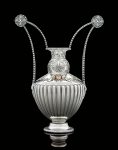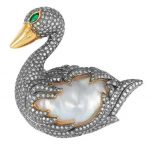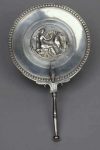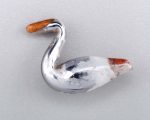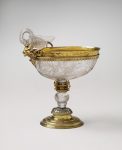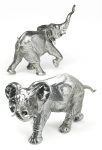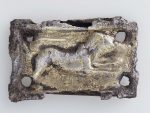Swans feature strongly in mythology. In Greek mythology, the story of Leda and the Swan recounts that Helen of Troy was conceived in a union of Zeus disguised as a swan and Leda, Queen of Sparta
Many of the cultural aspects refer to the mute swan of Europe. Perhaps the best known story about a swan is “The Ugly Duckling” fable. Swans are often a symbol of love or fidelity because of their long-lasting, apparently monogamous relationships.
A Thomas Webb and Sons cameo glass swan’s head scent bottle, dated 1884 The very elegant bottle in the shape of a swan’s head, cast in deep ruby glass overlaid in white and finely carved with feathers, the eyes and beak all carefully delineated, the silver screw cover by Charles Smith with London hallmarks for 1884, 23.3cm long, etched mark ‘WEBB’ in a square, carved registration number 11109 (lacking inner stopper)
Sold for £ 3,125 inc. premium at Bonhams in 2018
Hemiobol Silver coin.(obverse) Swan standing, right, on one leg with head reverted. (reverse) Quadripartite incuse square. Greek 500BC-400BC (circa)
Reference: © The Trustees of the British Museum
1900 PARIS EXPOSITION UNIVERSELLE: AN AMERICAN SILVER AND ENAMEL “POMPEIAN” VASE MARK OF TIFFANY & CO., NEW YORK, 1900, DESIGNED BY PAULDING FARNHAM On spreading circular base with gadrooned rim, rising to a amphora-form body chased with lobes spaced by reeded arches, the shoulders enameled with stylized red lyres and yellow flowers above scrolling green foliage, neck chased with shells and flowering vines, the upswung openwork handles cast with climbing vines and terminating in two swan heads, the handles topped by stylized pierced rosettes, marked on underside, numbered 13899-1120 and with 1900 Paris Exposition mark 18 ½ in. (47 cm.) high 98 oz. 16 dwt. (3,073 gr.)
Sold for USD 31,250 at Christies in 2019
Gold, Silver, Baroque Cultured Pearl, Diamond and Emerald Swan Brooch 14 kt., one pearl ap. 25.0 x 15.0 mm., one marquise-shaped emerald eye, ap. 17.3 dwt.
Sold for $2,500 (includes buyer’s premium) at Doyle New York in 2011
19th century Russian Silver and Crystal Ewer, by W.A. Bolin and KL (Konstantine Linke). Cut crystal body with overlay of sterling silver with lyre in center, flanked with double swan heads, stylized floral sprays, and swivel form handle with stylized tulip and three thistle type silver finials. The short narrow neck shows the crystal design of small double diamonds with asterisk in each, and the base has a large scale sunburst. Formerly property of Russian Imperial Family. Hallmark on cover 88, also on base including Bolin KL. 12 1/4″ High.
Sold for $12,000 at Stuart Kingston in 2019
The silver treasure discovered in 1895 at Boscoreale in a Roman villa buried by the eruption of Vesuvius in AD 79 contained only a few toiletry objects. However, like this mirror richly decorated with a mythological scene in relief, these luxury items made in the first century of our era reveal a flourishing period of Roman silverwork. The decoration representing the meeting of Leda and Jupiter, turned into a swan, is a hymn to femininity and sensuality.
Polished on one side to reflect the face of the user, this silver mirror is mounted on a baluster handle terminating in two heads of birds with long beaks and affixed to the disc by a stylized leaf of a design widespread in Campania. Although it might seem unusual, the presence of women’s toiletry objects in a treasure consisting mainly of tableware is hardly surprising. Mirrors were precious objects for the lady of the house and often hidden away in case of danger, in the same way as jewelry or dishes. The myth of Leda and the Swan The decoration of these luxury objects generally echoed their function, as is demonstrated by the medallion with the repoussé work decoration in relief on the back of the disc. The subject, taken from mythology, is a paean to feminine seductiveness and is well suited, therefore, for decorating a toiletry object. Extremely widespread in ancient iconography from the fourth century BC on, especially in silverwork, the scene depicts the meeting between Jupiter and Leda. After falling in love with the young woman, the god changed himself into a swan so that he could approach her and satisfy his passion. Seated on a rock and in an advanced state of undress, Leda is giving water from a patera to the bird whose outspread wings and claw resting on the girl’s knees show its impatience. The tale is handled with delicately sober refinement; sensuality emerges through allusions, without giving way to the sometimes crude eroticism of some illustrations of Jupiter’s romances.
Reference:The Louvre
Minute silver swan 18th century Made at Nevers (France)
Reference: Museum of Fine Arts Boston
A silver-gilt and cloisonné enamel swan-form kovsh, Ovchinnikov, Moscow, 1908-1917 elaborately enamelled with shaded polychrome feathers and foliage on raised surfaces, struck with maker’s mark beneath the Imperial Warrant, 84 standard length 29.3cm, 11 1/2 in.
Sold for 90,000 GBP at Sothebys in 2018
This is a cup made of rock-crystal, engraved with figures of Neptune and Amalthea, with silver mounts. Rock crystal is a transparent, colourless quartz. The art of carving rock crystal was known in Roman times and in Egypt under the Fatimid dynasty (909-1171). In Europe it was practised mainly in the north, but also in Italy. The Miseroni family, working in Milan then Prague from the 1550s, supplied the courts of Europe with rock crystal.
Reference: © Victoria and Albert Museum
Silver Swan Handled Ladle 4th-3rd century BC (Hellenistic)
Ladles in the Classical and Hellenistic periods had handles that rose nearly vertically, as they were used for dipping into deep wine containers, such as “kraters.” Ladles were often paired with strainers, and this example’s long, strap-like handle ends in the bent neck of a swan, matching the handles of the strainer, with which it was found.
Reference: The Walters Art Museum


